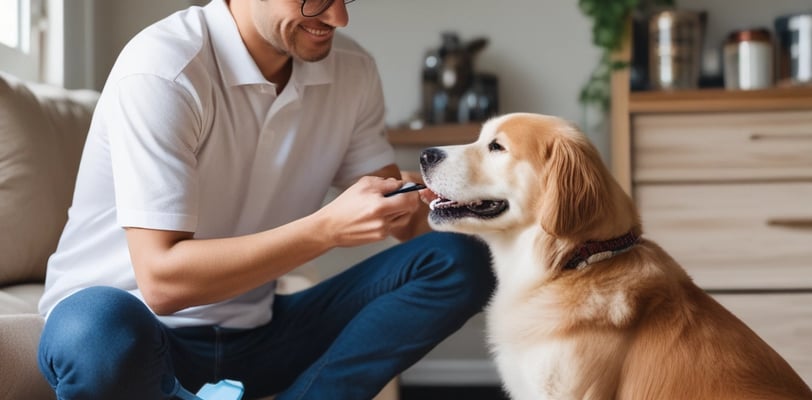How to Brush Your Dog's Teeth in 60 Seconds
A Simple and Effective Dental Care Routine
DOG BLOG
2/4/20253 min leer


How to Brush Your Dog's Teeth in 60 Seconds: A Simple and Effective Dental Care Routine
Maintaining a dog’s dental health is essential for its overall well-being. Brushing a dog's teeth can be done in just 60 seconds, making it an easy addition to their routine. Regular dental care can prevent serious health issues, saving pet owners time and money on veterinary billings in the long run.
With some preparation and the right tools, anyone can successfully brush their dog's teeth. A gentler approach and positive reinforcement can help ease anxiety, encouraging good behavior. This brief guide will walk through a simple, effective dental care routine that fits seamlessly into busy lifestyles.
By incorporating this quick brushing technique, dog owners can ensure their pets enjoy healthier teeth and gums. Starting early can make the process easier, fostering a positive experience for both the pet and the owner.
Preparing for the Routine
Establishing a successful dental care routine begins with the right preparations. This involves gathering essential supplies and selecting an appropriate time for the activity, ensuring a smooth experience for both the pet and the owner.
Gather Your Supplies
Effective dental care requires specific tools. Key supplies include:
Dog toothbrush: Choose one designed for dogs. These usually have softer bristles and a comfortable grip.
Dog toothpaste: Use toothpaste formulated for pets. Human toothpaste can be harmful to dogs because of ingredients like xylitol.
Finger brush (optional): This can be useful for smaller dogs or for pet owners who want more control while brushing.
Before starting, she should collect these items and have them in one accessible location. This organization helps avoid distractions during the routine and keeps the process efficient.
Choosing the Right Time
Timing plays a crucial role in making dental care enjoyable. It is best to pick a moment when the pet is calm and relaxed.
Suggestions include:
After a walk or playtime
When the dog is naturally winding down
Additionally, consistency in timing helps the pet become accustomed to the routine. She should aim for a similar time each day, creating a habit that eventually feels normal for the dog.
The Brushing Technique
Establishing an effective brushing technique is essential for maintaining a dog's dental health. The right approach includes selecting appropriate tools, using the correct product, and executing a quick brushing routine.
Introducing the Toothbrush
Selecting a suitable toothbrush is the first step. A dog-specific toothbrush, which often features softer bristles and ergonomic designs, is ideal. For smaller dogs, a finger brush can provide more control.
Before brushing, she should allow her dog to familiarize itself with the toothbrush. This can be done by gently letting the dog sniff and lick it. Gradually introducing the toothbrush can help reduce anxiety and make the actual brushing process smoother.
Applying the Toothpaste
Choosing the right toothpaste is crucial. Never use human toothpaste, as it contains ingredients harmful to dogs. Instead, opt for dog-friendly toothpaste, which comes in flavors like chicken or peanut butter that appeal to them.
Apply a small amount, about the size of a pea, onto the brush. Instruct the dog to lick some of the toothpaste off the brush first. This encourages acceptance of the brushing routine and helps get them accustomed to the taste and texture.
The 60-Second Brushing
When ready to brush, she should gently lift the dog’s lip to expose the teeth. Start with the back teeth, as they are often the most prone to plaque buildup. Use short, circular motions, concentrating on both the outer and inner surfaces of the teeth.
Brush for about 60 seconds total, focusing on one quadrant of the mouth at a time. This structured approach makes it easier to ensure all areas receive attention while keeping the session brief. After finishing, reward the dog with praise or a treat to reinforce positive behavior.
Aftercare and Monitoring
After brushing a dog’s teeth, implementing proper aftercare and monitoring is essential for maintaining oral health. This involves rewarding the dog and keeping an eye on any changes in dental condition.
Rewards and Positive Reinforcement
Positive reinforcement helps make dental care a non-stressful experience for dogs. After brushing, giving a small treat or engaging in playtime can build a positive association with the process.
Consider using dog-safe dental treats.
Praise the dog verbally to reinforce good behavior.
Establishing a routine that links teeth brushing with positive experiences makes it more likely that the dog will tolerate the activity in the future. Consistency is key; the more they associate brushing with enjoyable outcomes, the easier it becomes for both the dog and the owner.
Monitoring Dental Health
Regular monitoring of the dog's dental health is crucial. Pet owners should check for signs of dental issues, including:
Bad breath
Red or swollen gums
Loose or missing teeth
Routine vet visits are important for professional evaluations. Keeping a record of any changes can help identify potential issues early. Regular inspections at home support ongoing dental hygiene and empower owners to make informed decisions about their dog's dental care. Maintaining awareness ensures that any problems are addressed promptly.
